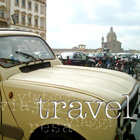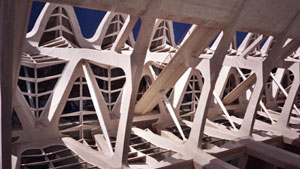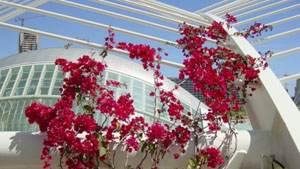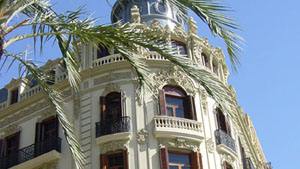
|
VALENCIA: SUNSOAKED ENLIGHTENING MYTHIC ORANGE GROVES, OLD-CITY STROLLING, REVOLUTIONARY ARCHITECTURE Updated 26 February 2006 Spain's third largest city, Valencia is the bustling capital of the autonomous region called the Comunidad Valenciana. The surrounding landscape is laced with geometrically plotted orchards and orange groves and is famed for its agricultural richness and productivity. Throughout its varied history, Valencia has been ruled, like many Spanish cities, by a number of distinct civilizations, and now displays a commitment to blending the ancient with the modern in creating a city with an energy like no other.
Valencia is one of the Spanish regions that uses a language other than Castilian Spanish. Valenciá has roots in the development of Catalán, and is officially considered by scholars to be an offshoot of Catalán, but Valencianos will insist on the name Valenciá., as evinced by the regions's autonomous TV stations being self-pronouned "en valenciá". Nevertheless, like everywhere else in Spain, all of the natives speak Castilian Spanish as well, so tourists with a knowledge of Spanish will get along with ease. The contemporary treasure of Valencia is the stunningly unique City of the Arts and Sciences, featuring a number of abstract, bright-white, confounding architectural designs. Even before its completion, it had become the fourth most visited tourist attraction in Spain, and is now preparing to be fully operational. The complex includes the Museu de les Ciències, the Umbracle (open-air arcade entry to the complex, with botanical gardens, climbing vines), L'Hemisfèric (planetarium modeled on "the eye of wisdom"), L'Oceanogràfic (a vast and innovative aquarium, connected to the Mediterranean), and the Palau de les Arts, designed by native Valencian architect, Santiago Calatrava.
This final component of the complex pays direct homage to the cultural interests of the Valencian and Spanish people. The structure will include multiple performance spaces, including a large music hall, and will provide a venue for opera, dance and theatre. During our own visit, we met a man who claimed to have been born on the site of the new planetarium in the 1920s, who said it made him misty with joy to think that his city had chosen this spot to place its contribution to world culture. The city is busy and tempestuous, streets jammed with traffic, always moving in one direction, and to the outsider, an indecipherable labyrinth. So the convenience of the Estació del Nord, the city's centric train station, cannot be overstated. Coming into Valencia by RENFE, one emerges right into the heart of the city, beside the Plaza de Toros and within blocks of the Plaça del Ajuntament.
From there, most of the main attractions are within walking distance, if not accessible by taxi or bus. The city's center combines large public plazas, lined with elegant façades and stuffed with traffic, and narrower, intimate streets and alleyways, winding toward the cathedral. The city's history extends back to the Phoenicians, and before Roman times, Valencia was inhabited by the Iberians. Greeks, Romans, Visigoths, and Muslims, all conquered and ruled Valencia throughout its history. The area was heavily influenced by Roman occupation, later enjoyed the privilege of serving as a political and financial center for Moors during their reign on the Iberian Peninsula. In historic and chivalric fashion, the famed knight El Cid Campeador, immortalized in epic poetry and folklore, recaptured the city for the Spanish Christians. It would again fall, however, to the Almoravids, and remain under Muslim control until 1238, when Jaume I of Aragón reconquered the city. Valencia was then established as a Christian kingdom, with its own legislative principles, and with autonomous powers under the protection of Jaume I. The 15th and 16th Centuries correspond to what is historically considered Valencia's 'Golden Age', when it became an economic power in Mediterranean trade. Valencian culture also flourished during this time, as embodied by the author Joanot Martorell, whose Tirant lo Blanc is considered the first modern novel in Europe. Other creative luminaries include Ausias March, Jordi de Sant Jordi, Jaume Roig and Isabel de Villena. During the War of Spanish Succession, at the beginning of the 18th Century, Valencia took sides against the victorious Bourbons, and was persecuted as a result. Its language and its special legal privileges (Furs or Fueros) were revoked. As in Catalunya, and elsewhere in Spain where languages and cultures were suppressed in attempts to centralize Spanish power, Valenciá persisted. Franco's fascists renewed the persecution of regional cultures, postponing Valencia's return to autonomous rule until the early 1980s. Today, the Comunidad Valenciana is governed by its own independent Generalitat, or autonomous regional government. The city itself offers a broad array of unique and charming experiences, whether in walking, shopping, dining, sightseeing, and/or basking in the sun. By day, the city's busy life invites the visitor to all of these. Sunbathing in particular can be enjoyed along the coast both north and south of Valencia, in any number of resort towns.
An evening stroll through the city center delivers up sidewalk cafés, late dining opportunities, street performers, and the atmosphere that only a place with such brilliant daylight can bring by night. Another great tradition of Valencia is boating, or sailing more specifically, and Valencia has the fortune to have won the right to host Switzerland's defense of the America's Cup, in 2007. Opportunities exist for studying Spanish language and sailing in a single trip, or for renting boats for a modest tour of the coastline. A tourist attraction that draws genuine affection from visitors is L'Albufera, a natural preserve which is also classified as a bird sanctuary and an internationally protected wetland. Though a protected natural landscape, the park hosts a number of activities in which human beings interact with the environment, including hunting, fishing, and the farming of a prized rice harvest. These activities are maintained as representative of the local cultural heritage, and are conducted within the historically tested scope which fits within the natural balance of the local ecosystems. The Albufera zone is also used as a means of studying ecosystem elasticity and the flora and fauna which exist there in a protected natural state. Beyond the shock of Valencian sunlight, revolutionary architecture, the famed orchards of the surrounding country and a unique natural preserve, visitors may be intrigued by visits to nearby cities like Sagunt, which contains ruins dating back to Roman times, and may provide a more concentrated look at Valencian life, as such, untainted by the universalities of the urban experience. [s]
For more travel listings, original narratives and destinations, consult Sentido's sister site for travel, CavaTravel.com... |
|||||||||||||||||||||||||||||||||||||||||||||||||||
|
||||||||||||||||||||||||||||||||||||||||||||||||||||












